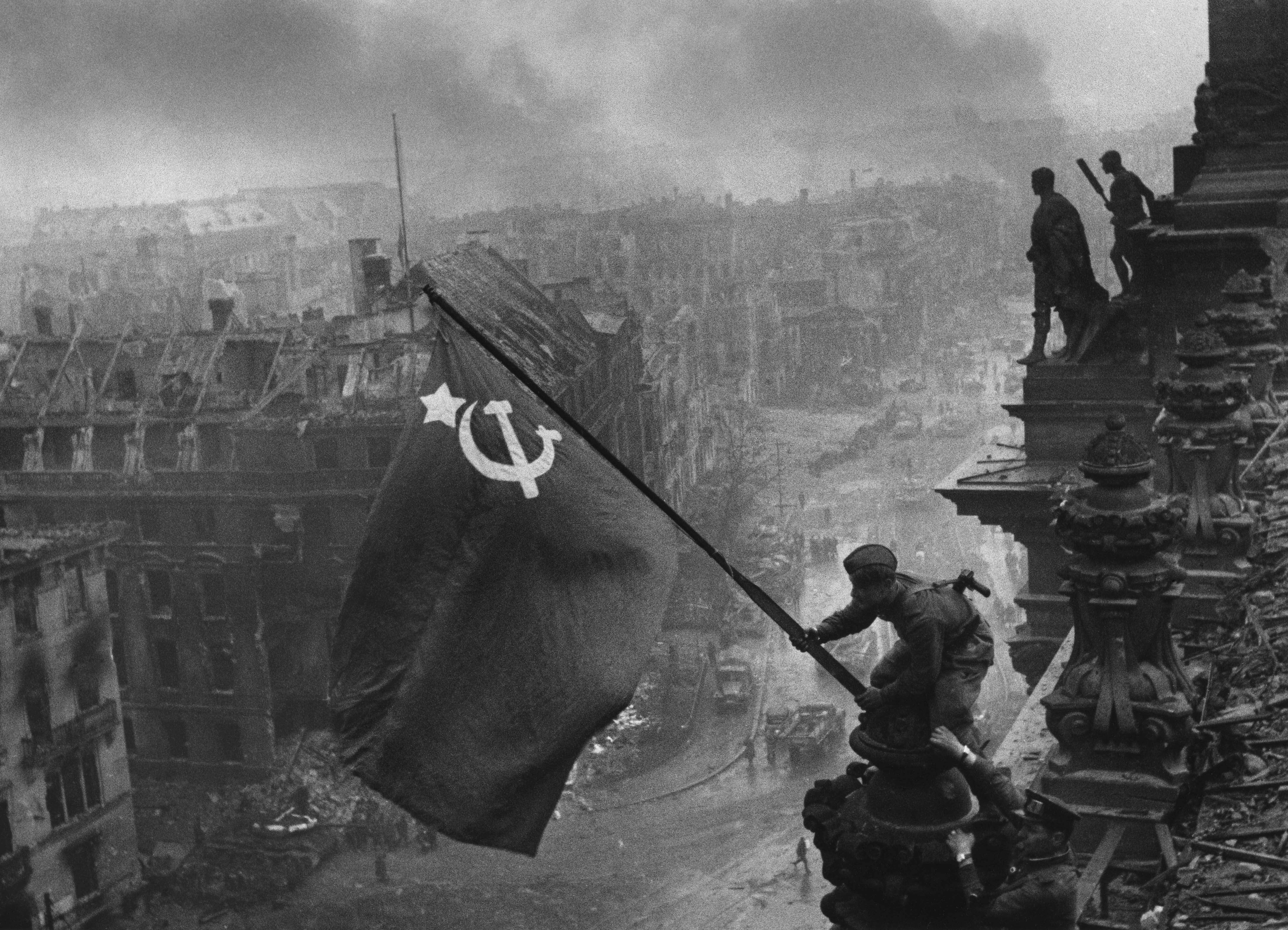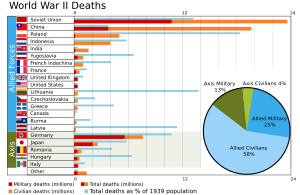More languages
More actions

World War II, also known as the Second World War, was a global armed conflict that lasted from 1 September 1939 to 2 September 1945. With an estimated total of 70–85 million people dead, it is considered the deadliest conflict in human history.
Background[edit | edit source]
Rise of fascism[edit | edit source]
Adolf Hitler took power in Germany in 1933. Francisco Franco launched a coup against the Second Spanish Republic in 1936, leading to a civil war.[1] Italy and Germany supported the Spanish fascists while Britain and France stayed neutral. Japan and Germany signed the Anti-Comintern Pact in 1936, and Italy joined soon after.[2]:185–90
Fascist expansion[edit | edit source]
Following the Italian invasion of Ethiopia in 1935, the USSR proposed a collective security system for Europe and signed defense treaties with France and Czechoslovakia.[2]:185–7 Fascist Japan invaded northeast China in 1931 while the ruling Kuomintang focused on fighting the Communists instead of the Japanese invaders.[1] Italy occupied and colonized Ethiopia in 1935. Germany annexed Austria in March 1938 after announcing a supposed communist uprising. In May, Germany annexed part of Czechoslovakia with support from the West.[2]:185–90
Attempted anti-fascist alliance[edit | edit source]
In March 1939 after Germany annexed the rest of Czechoslovakia, the USSR tried to organize an anti-fascist alliance with France and the UK. From June to August, the British secretly met with the Nazis and agreed to allow Germany to invade Eastern Europe in exchange for guaranteeing the integrity of the British Empire. The USSR also proposed a defense agreement with Poland, but Poland refused, and the USSR signed a non-aggression pact with Germany on 23 August 1939.[2]:185–90
Class character[edit | edit source]

The character of the war is subject to some contention due to the factor of the socialist Soviet Union as a participant, unlike the First World War which was characterised as an imperialist war for the redivision of the world among the 'great powers' where capitalism had reached its monopoly stage. During the period from the invasion of Poland in September 1939 to the invasion of the Soviet Union in June 1941, the Comintern designated the war as a second imperialist war and did not co-operate with their respective bourgeois governments and then seemingly reversed their position, something which they are highly maligned for.[citation needed]
British Communist Rajani Palme Dutt clarified that the entry of the Soviet Union only augmented the 'anti-fascist, liberating character' of the war.[3] The fascist invasions culminated in more than 30 million casualties in Europe, and more than 61 million worldwide. The war consisted of a reactionary phase when the ruling classes appeased fascism and did not co-operate with the Soviet struggle for self-determination and then the phase of the united struggle of the peoples against fascism when the Great Alliance was formed in 1941.
Asia-Pacific theatre[edit | edit source]
Northeast Asia[edit | edit source]
Japan began its colonial expansion before the outbreak of the war. It invaded Manchuria in 1931 and reached the Soviet border, provoking fears of war.[2]:185–90 In 1932, Kim Il-sung founded a guerrilla army to resist the occupation of Korea.[4]
The USSR signed a mutual defense agreement with Mongolia in 1934. Mongolia's military spending grew from 34.7% of the state budget in 1934 to 52.5% in 1938, and the term of military service increased from two to three years. In 1938, Japan attacked the Soviet Union at Lake Khasan and tried to capture Vladivostok.[5]:344–6
Due to repeated Japanese border attacks, Mongolia requested Soviet troops to return in 1937. Japanese aggression increased in early 1939, and Japan launched a full invasion on 1939 May 11. The People's Army fought them at the Halkhin River on May 28 and surrounded them with support from the Soviet Red Army in August. Japan lost 60,000 soldiers (killed or wounded), 700 planes, 340 machine guns, and 12,000 rifles. A peace treaty signed in Moscow took effect on September 15.[6]:349–50
On 8 August 1945, exactly three months after Germany surrendered, the Soviet Union sent troops into Manchuria and Korea to oust the Japanese colonizers.[4]
Pacific Ocean[edit | edit source]
Japan attacked U.S. forces at Pearl Harbor in Hawaii in 1941 and then colonized Indonesia, the Philippines, Malaya, and New Guinea while the USA was recovering.[4] The USA fought an island-hopping campaign and gradually moved towards Japan. Up to 140,000 people, mostly civilians died in Okinawa during the U.S. invasion.[7]
The United States used atomic bombs against the Japanese cities of Hiroshima and Nagasaki in August 1945, killing 443,000 civilians.[8]
European theatre[edit | edit source]
Poland[edit | edit source]
Germany invaded Poland on 1 September 1939, beginning the European theatre of the war. The Soviet Union forced Germany not to cross the Thasse, Narew, Bug, or Vistula rivers. Following the invasion, France and Britain declared war on Germany but did not actually begin fighting yet.[2]:185–90 The Nazis used 80% of their strength on the Eastern Front, where they lost over three million soldiers.[9]
Winter War[edit | edit source]
Though not yet directly involved in the war in late-1939, there were strong fascist and pro-Nazi elements in Finland, and the Soviet government was concerned that at some point or another, Finland might align itself with Nazi Germany, leading Germany to launch an invasion of the Soviet Union from Finland (as the Finnish border was a mere 32 km away from the major port city of Leningrad, and the capture of Leningrad could have had disastrous effects for the Soviet Union).
Due to these concerns, the Soviet government sent a message to the Finnish government on 14 October 1939, asking for Finland to cede the Port of Hanko, the Karelian Isthmus, and four islands to the USSR. This would have effectively given the Soviets naval superiority in the Baltic Sea and made it much more difficult for the Germans to send troops to Finland by boat. In exchange, the Soviets offered Finland a portion of Karelia twice the size of all the other areas combined.
Finland refused however, and on 30 November, the Soviets invaded Finland following the Shelling of Mainila, a false flag operation conducted by the NKVD. Britain, France, Italy, and the United States sent a total of 700 planes, 1,500 cannons, and 6,000 machine guns to Finland. France and Britain also sent 150,000 soldiers to Finland, but Finland sued for peace in March 1940, before the Anglo-French troops could arrive.[2]:185–90
Western Front[edit | edit source]
The Nazis invaded Western Europe in May 1940 and began bombing the UK in July. France fell within six weeks. In September 1940, the USA gave 50 old destroyers to the UK in exchange for taking control of British bases in the Americas. The bases were located in eight British colonies: Antigua, the Bahamas, Bermuda, Guiana, Jamaica, Newfoundland, and Saint Lucia, and Trinidad.[10]:223–4 The U.S. bases prevented Germany from colonizing the Caribbean, Iceland, or Greenland after it took over France, the Netherlands, and Denmark.[10]:235
The USA created the Lend-Lease program to give military aid to at least thirty countries, starting with the UK. China, Greece, Norway, and the Soviet Union later joined the program.[10]:237
Eastern Front[edit | edit source]
Nazi Germany invaded the Soviet Union on 22 June 1941. General Dmitry Pavlov's incompetence caused the loss of Minsk, the capital of Belarus, on 28 June, and the Military Council ordered his execution.
The Battle of Smolensk began on 10 July 1941 and lasted two months, with Germany losing 250,000 soldiers. The Nazis began their final offensive towards Moscow on 30 September, and 450,000 of the city's inhabitants mobilized to build fortifications and anti-tank defences. Germany bombed Moscow, but their offensive was defeated in early November. The Nazis attempted a second offensive against Moscow on 15 November and occupied some of its southern suburbs but were defeated on 5 December, and the Red Army began a counteroffensive of 720,000 soldiers that pushed 800,000 Nazi soldiers back 100 to 300 km.
The Red Army failed to liberate Crimea in April 1942, and the Nazis counterattacked on 8 May. In May 1942, Aleksandr Vasilevsky, a former assistant to Zhukov, became Chief of Staff. Konstantin Rokossovsky became the commander of the Bryansk front in July. On 23 August 1942, 1,000 German planes began bombing Stalingrad and set the city on fire.[2]:224–31
The Red Army entered Hungary on 23 August 1944, and Hungary's fascist leader Horthy expected the West to support him against the Soviets.[8]
Middle Eastern theatre[edit | edit source]
In late 1939, French General Maxime Weygand went to Syria and Turkey to prepare an attack against the Soviet Union and planned to bomb the Baku oilfields.[2]:185–90 The United States used North Africa to transport cargo by air to Cairo. 65,000 U.S. troops and civilians in Iran and nearby countries transported supplies to the Soviet Union.[7]
References[edit | edit source]
- ↑ 1.0 1.1 John Ross (2022-09-13). "The United States Is Waging a New Cold War: A Socialist Perspective" Tricontinental. Archived from the original on 2022-11-04. Retrieved 2022-11-19.
- ↑ 2.0 2.1 2.2 2.3 2.4 2.5 2.6 2.7 2.8 Ludo Martens (1996). Another View of Stalin: 'Stalin and the anti-fascist war'. [PDF] Editions EPO. ISBN 9782872620814
- ↑ Rajani Palme Dutt (2005). On the Character of the Second World War. On the 60th anniversary of the victory over Nazi Germany.
- ↑ 4.0 4.1 4.2 Stephen Gowans (2018). Patriots, Traitors and Empires: The Story of Korea’s Struggle for Freedom: 'The Patriot' (pp. 66–72). [PDF] Montreal: Baraka Books. ISBN 9781771861427 [LG]
- ↑ A. A. Guber, et al. (1973). History of the Mongolian People's Republic: 'The Mongolian People in the Fight for Development on Non-Capitalist Lines'.
- ↑ A. A. Guber, et al. (1973). History of the Mongolian People's Republic: 'The Mongolian People in the Fight for Development on Non-Capitalist Lines'.
- ↑ 7.0 7.1 David Vine (2020). The United States of War: 'Empire of Bases' (pp. 247–8). Oakland: University of California Press. ISBN 9780520972070 [LG]
- ↑ 8.0 8.1 Ludo Martens (1996). Another View of Stalin: 'From Stalin to Khrushchev' (pp. 242–244). [PDF] Editions EPO. ISBN 9782872620814
- ↑ Austin Murphy (2000). The Triumph of Evil: 'A Detailed Autopsy of the Collapse of the Superior System in the Divided Germany' (p. 113). [PDF] Fucecchio: European Press Academic Publishing. ISBN 8883980026
- ↑ 10.0 10.1 10.2 David Vine (2020). The United States of War: 'Reopening the Frontier'. Oakland: University of California Press. ISBN 9780520972070 [LG]
